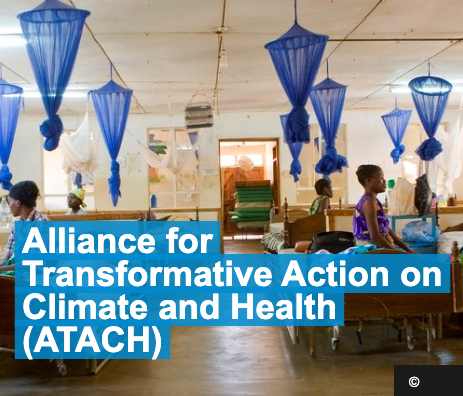
Health systems are increasingly faced with climate change driven extreme weather, disease epidemics, migration, economic downturns, and infrastructure failures. Climate-related hazards can simultaneously impact healthcare service delivery and increase the number of people needing medical attention – negatively affecting the capacity of health systems to protect and promote population health. Both acute shocks and chronic climate stressors on these systems can have a deep and lasting impact on health and human development.
Kruk et al. propose five elements for a resilient health system:1 1Climate-Smart Healthcare: Low-Carbon and Resilience Strategies for the Health Sector
For a health system to effectively prepare for climate change it must enhance the climate resilience of each of its building blocks: leadership and governance, the health workforce, health information systems, essential medical products and technologies, service delivery, and financing.
The WHO operational framework for building climate resilient health systems describes 10 components under the building blocks that, when strengthened, reduce climate change risks to health systems.
Strengthening health systems, including healthcare facilities, is a key part of health adaptation planning, and should be included in a Health National Adaptation Plan.
The process to build climate-resilient health systems includes activities such as:
These activities may be integrated into the overall national climate change process, such as the Nationally Determined Contributions (NDCs) and the health component of the National Adaptation Plan.
A healthier population and stronger health system will be more resilient to climate change. In order to reduce vulnerability and create resilient health systems and healthier populations that are able to respond to potential health effects from climate change, the following measures are recommended:
Addressing current gaps and improving the current health system or programme performance is not enough to prepare a health system to tackle climate change. Health systems should increasingly take steps to understand how climate change will affect their population and service delivery, evaluate the effectiveness of their interventions and systems under diverse climatic conditions, and enhance their institutional capacity accordingly. To do this, public health and health system capacities that are attuned to climate realities are needed.
Adaptive management is a structured and iterative process of decision-making and implementation that is especially useful in the context of uncertainty. Using tools and approaches that seek and apply feedback and new information to decision-making facilitates adaptive management.
For example, risk assessments clarify the scale of local needs; clients, staff and partners surveys provide insights on effectiveness; monitoring identifies stepwise changes in conditions; scenario-planning of project performance and failure under diverse conditions identifies limitations; and pilot projects or testing helps improve project or process design before scaling up.
Each of these processes or tools provides ways of introducing phased implementation and allowing for adjustments and modifications to be made based on early lessons and available information.
Community action is critical to achieve climate resilience relevant in each of the 10 components of the WHO operational framework for building climate resilient health systems. Partnerships between government, academic institutions, civil society and communities are key to understanding the nature of local risks and vulnerability, and to developing appropriate solutions to protect health.
Communities can play an important role in improving the quality of assessments, risk monitoring, communications, capacity building and programming. Community-based action is a principal mechanism for ensuring that people themselves are informed and able to take appropriate action to protect and maintain their health.
Resilience can be strategically built through good development policy and practices that take climate change into consideration and empower communities.
The health sector contributes to emission levels through the energy and transport it relies on, as well as the products that it purchases, uses, and disposes of. It is also at the forefront of the fight against climate impacts – preventing and responding to the health impacts of the changing environment.
The design and maintenance of public health infrastructure may be the most important, cost-effective and urgently needed strategy for healthcare systems to adapt to our changing climate. Infrastructure that is specifically designed to reduce vulnerability to climate variability can greatly enhance adaptive capacity. This applies to healthcare infrastructure – such as flood control systems, air conditioning, and building insulation – as well as public infrastructure that supports healthcare systems and healthy communities – such as water and sanitation facilities and laboratories.
WHO2 2Climate-Smart Healthcare: Low-Carbon and Resilience Strategies for the Health Sector3 3WHO guidance for climate resilient and environmentally sustainable health care facilities identifies four fundamental requirements for providing safe and quality care in the context of climate change:
Enhancing healthcare infrastructure to withstand climate shocks presents an opportunity to reduce the sector’s climate impact. Adopting low-carbon approaches can minimize the negative environmental impacts of supply chains and buildings, while equipping the sector with resilient technologies for future climate scenarios.
In 2021, greenhouse gas (GHG) emissions from the healthcare sector were 9.5% higher than in 2020 and 36% higher than in 2016. Associated air pollution from the sector contributed to 4.6 million Disability-Adjusted Life Years (DALYs) lost in 2021.4 42024 Report of the Lancet Countdown
Low-carbon healthcare offers a strategy for designing, building, operating, and investing in health systems that generate minimal GHG emissions. This approach aligns healthcare development with global climate goals, reducing energy and resource costs, and potentially improving quality of care across diverse settings.
Additionally, low-carbon healthcare strengthens health systems by making facilities more resilient to extreme weather and other disasters. In low-resource and energy-limited areas, low-carbon solutions can expand access to care, supporting institutional goals and advancing climate adaptation efforts.
Key elements of low-carbon healthcare include:
Research
EN
Research
EN
Research
EN